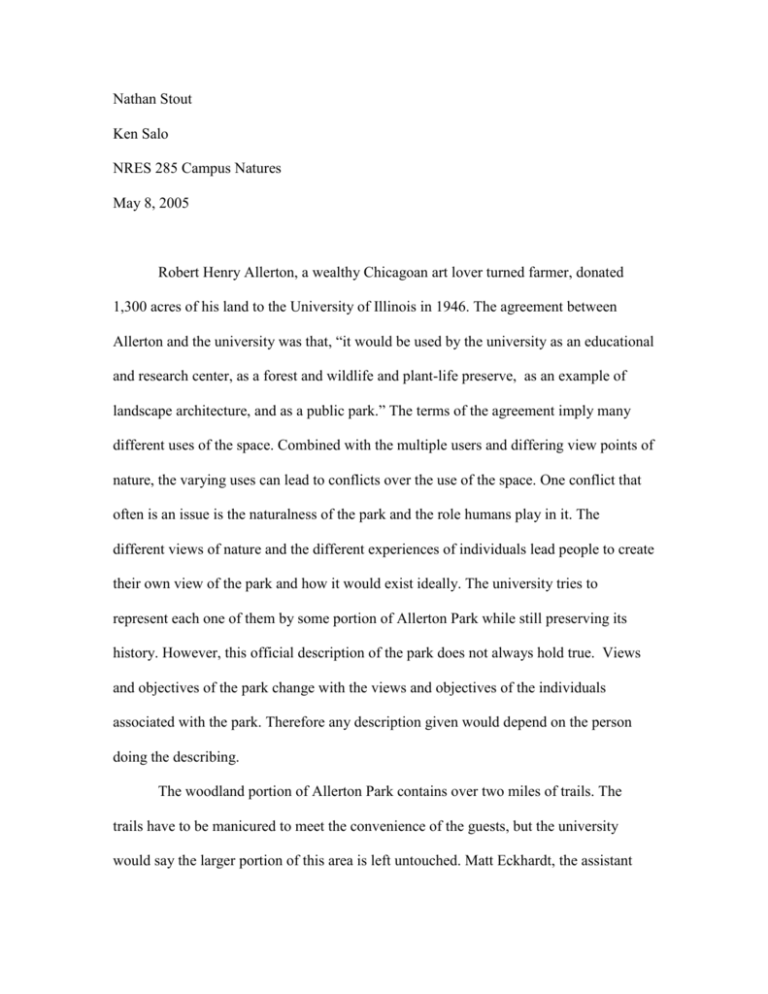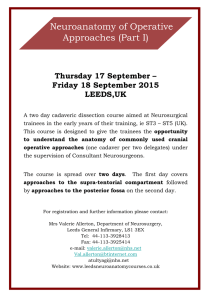Allerton285FinalThoughts
advertisement

Nathan Stout Ken Salo NRES 285 Campus Natures May 8, 2005 Robert Henry Allerton, a wealthy Chicagoan art lover turned farmer, donated 1,300 acres of his land to the University of Illinois in 1946. The agreement between Allerton and the university was that, “it would be used by the university as an educational and research center, as a forest and wildlife and plant-life preserve, as an example of landscape architecture, and as a public park.” The terms of the agreement imply many different uses of the space. Combined with the multiple users and differing view points of nature, the varying uses can lead to conflicts over the use of the space. One conflict that often is an issue is the naturalness of the park and the role humans play in it. The different views of nature and the different experiences of individuals lead people to create their own view of the park and how it would exist ideally. The university tries to represent each one of them by some portion of Allerton Park while still preserving its history. However, this official description of the park does not always hold true. Views and objectives of the park change with the views and objectives of the individuals associated with the park. Therefore any description given would depend on the person doing the describing. The woodland portion of Allerton Park contains over two miles of trails. The trails have to be manicured to meet the convenience of the guests, but the university would say the larger portion of this area is left untouched. Matt Eckhardt, the assistant manager of the parks visitor’s center explained, “We keep it as natural as possible and let nature kind of run its course.” Due to this stewardship in most of the park, it was dubbed a National Natural Landmark in 1971. Even though the university describes the area as untouched, I would argue differently. From my own experiences at Allerton Park I discovered that there are little, if any, areas of Allerton Park are untouched. Trails, roads, and statues all break up the woods here and there. Each one of these things takes away from the naturalness of the area. When I worked at the park during spring break we were always cutting trees to clear paths or make room for a research project. We also planted saplings in the forest for a research project. Other research projects took from the naturalness as well. Cages to prevent animals from nibbling trees, equipment tearing up the forest floor, and people crashing through the underbrush all impede the universities policy. Prescribed burns are also practiced to keep the underbrush down and eliminate some of the invasive species. Keeping the invasive species out of the woods is important to preserve the naturalness of the area but at the same time the burns are started and controlled unlike they would naturally. These views are mine and mine only. Since no one has shared my experiences at the park they can not look at the park form the same perspective that I do. Everyone has their own experiences and views within and outside of Allerton Park that shape their opinions and descriptions of the space. Some of these may agree with the universities official description and some my completely contradict it. None of these views are right or wrong. It is important, though, to consider many of the viewpoints when solving problems within the park. Problems arise between the groups when the interests and views of the groups and the interests of the park itself overlap. One of the most recent conflicts at the park was over how to handle the deer over-population. Because of the health of the park and the sanctuary it provides to whitetail deer, the number of them has climbed to an unreasonable amount. The deer and park both suffer as a consequence. Problems with inbreeding and competition for food lower the health of the deer herd. The browsing of the deer eliminates most of the small saplings, wild berries, and wildflowers lower the health of the park. The deer become a problem for visitor as well. Deer damage the gardens and eat the flowers visitors come to see. Visitors usually don’t like stepping in deer scat every few feet either. Also, the deer get on the road and endanger the visitor’s safety if they were to hit one. When the time came to do something about the problem people argued for different ways to limit the number of deer. Some even argued that nothing should be done at all and to keep the park natural nature must run its course. When I was at the park the deer over-population was definitely noticeable. There were deer everywhere you went and the bottom of every short tree was missing its leaves from the deer grazing on them. The park even has to put special fences around the gardens in the winter time, when food for deer is scarce, to keep them from eating all of the flowers and shrubs. After seeing the effects of the over population I agree that something had to be done, even if it does interfere with the naturalness of the area. A debate that took place years ago threatened the parks very existence. In the late 1960’s into the 1970’s the Army Corps of Engineers proposed a plan to place a dam on the Sangamon River, which runs right through the heart of Allerton Park, to serve as flood control and supply the city of Decatur with water. The Springer Project as it was called, upon completion, would have increased the natural flooding of the Sangamon River causing changes in the vegetation and natural ecosystems of Allerton Park. Protesters of the dam claimed the increased flooding would have detrimental effects on the park. Supporters argued that the dam would serve several purposes including flood control, a reliable water source for Decatur, and water recreation. They also argued that the effects on the park would be minimal and its plant life would not be significantly impacted. The controversy was felt across the nation and eventually was brought to a court case in Washington. Eventually the project was ended but not before years of conflict and debate, much of which revolved around the effects on Allerton Park. The debate over the dam illustrates the conflicts created by differing material and social needs of different groups. In this case, the interests of the Allerton Park were put up against the interests of the surrounding area. An outside power, the Army Corps of Engineers, looked at the area a saw the resources that a dam would provide for the area. At first however, they ignored the thoughts of the citizens in the area. They thought the local people would benefit from the dam but after the townspeople spoke up it was realized that the area that they would loose was more valuable to the local people than the resources they would gain. Without the local people rising up and voicing their ideas and views would have been completely overlooked. As I have gained knowledge of Allerton Park I have started to look past the official descriptions of the park that the university put in front of me and gain develop my own unique description of the Park. It has helped me to really see the park in a new more personal light and enjoy it to its full potential. I have seen how the history of the park has significantly affected the present and how differing views can lead to debates over how to resolve problems. Most importantly the knowledge I gained made me realize how many viewpoints exist. Now that I know how many views exist I have a better understanding of each one and I am more capable of solving problems as a result.





